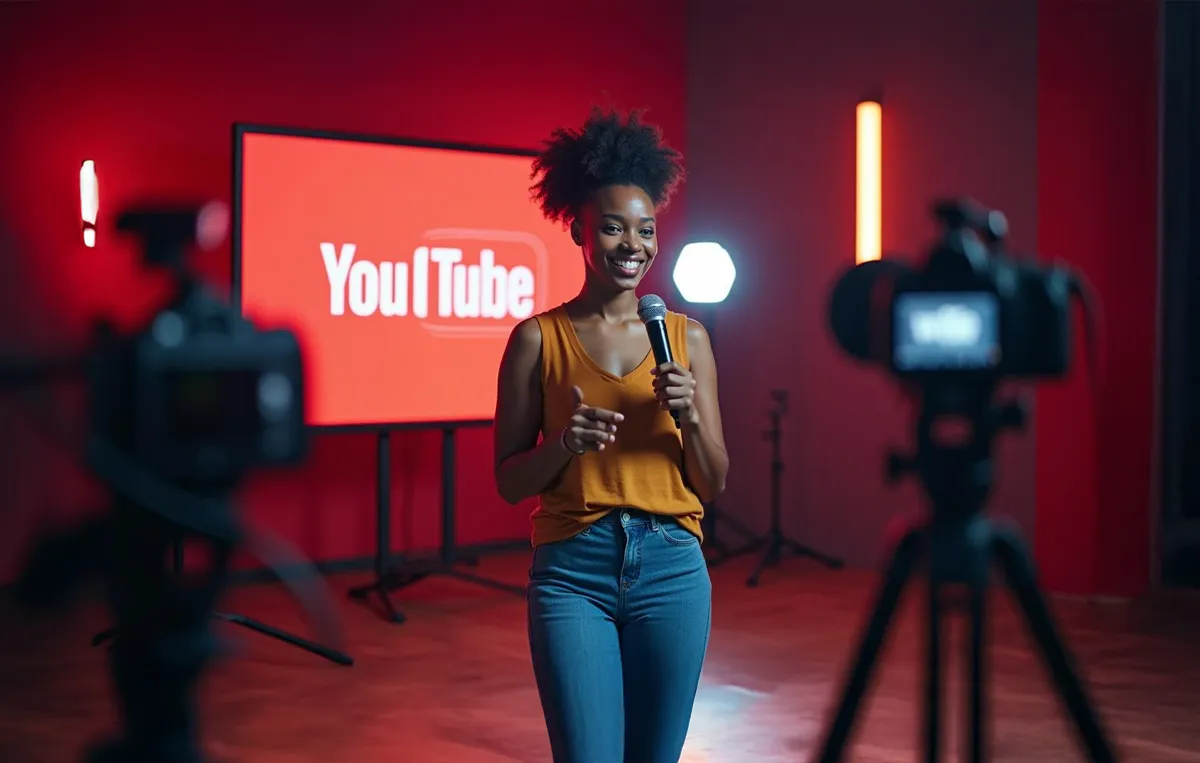YouTube Influencers are the kernel of a booming creators’ economy. Their work contributed an escalating $35 billion to the U.S. economy and supported more than 390k full-time jobs.
These Influencers don’t just entertain – they shape the latest trends, help build communities, and manage buying decisions, making them irreplaceable partners for business.
This blog will uncover some actionable ways to help you find and collaborate with YouTube Influencers who can amplify your key message and deliver measurable impact.
Before anything else, here’s what you need to know.
Not all influencers bring real value. Some have large subscriber counts but low engagement. Others create content that doesn’t resonate with their audience. Partnering with the wrong influencer can lead to a wasted budget and little to no impact.
So, here’s a glimpse of which type of influencers would work best for your brand based on your domain:
- Tech & Gadgets: Review influencers work best as they offer in-depth tech product analysis.
- Beauty & Skincare: Makeup artists & skincare influencers work best as they provide tutorials and product recommendations.
- Fitness & Wellness: Health vloggers work best as they engage audiences with workout routines and nutrition advice.
- E-commerce & Retail: Unboxing influencers work best as they showcase products and generate excitement.
- Food & Beverage: Culinary creators work best as they make brands stand out through engaging recipe videos.
- SaaS & Digital Tools: Tech educators work best as they break down software use cases for a wider audience.
Now, let’s see how to find the perfect YouTube Influencers who truly fits your brand.
1. Use Influencer Marketing Platforms or Tools
Influencer marketing platforms are powerful tools that help brands discover, analyze, and connect with the right YouTube influencers. These platforms provide in-depth insights like audience demographics, engagement rates, content performance, and many more things.
Why Does It Matter?
Manually searching for influencers can be time-consuming and may not always yield the most relevant creators. With influencer marketing tools, you can refine your search by filtering influencers based on niche, audience location, and engagement levels.
How to Do It?
Start with a simple search on any free influencer marketing tool. Enter your industry keyword, such as “budget travel vlogs,” and the tool will pull up a list of YouTube influencers creating content in that space. Look for key metrics like subscriber count, engagement rate, and content consistency to ensure their audience matches your target market.
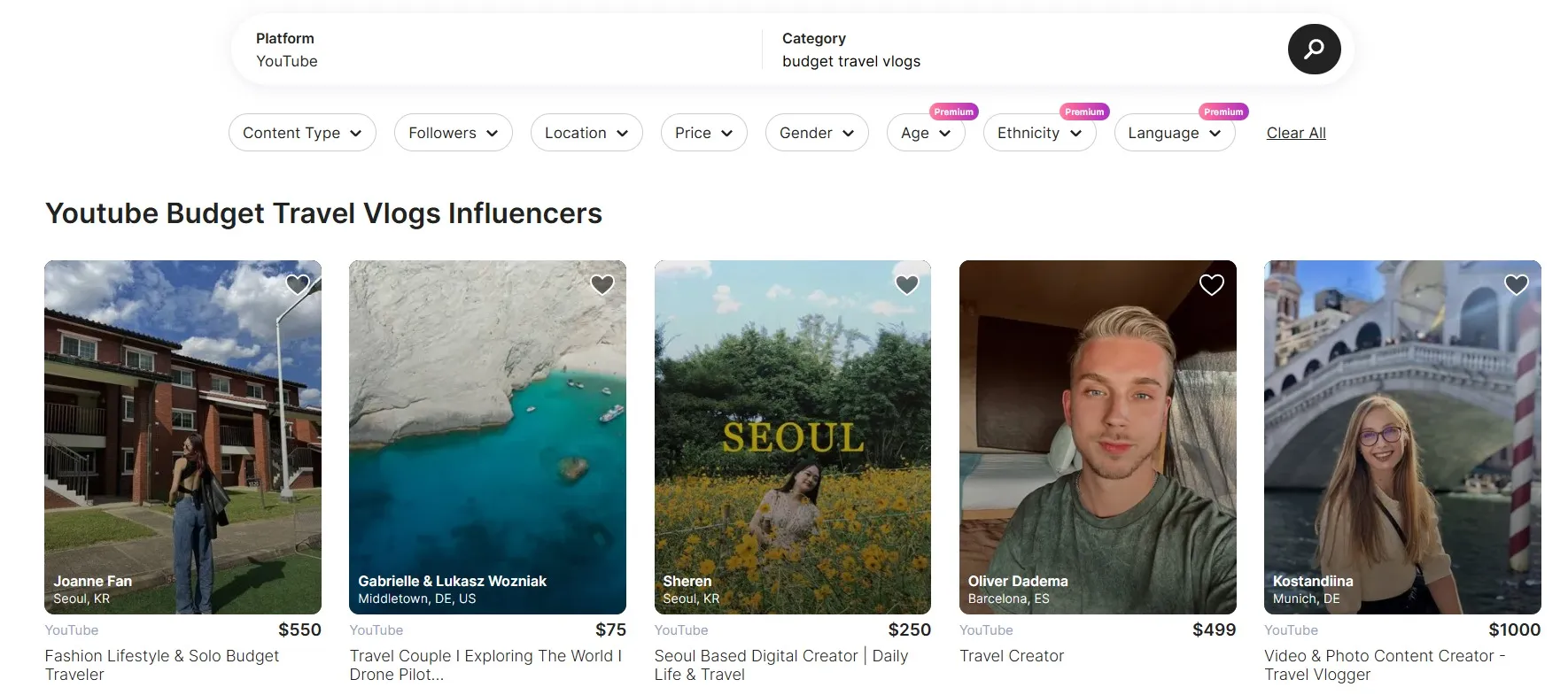
Relying solely on manual methods can be sluggish, while influencer marketing tools simplify the process. Pairing tools with strategic searches can give you the best finds and save time.
Tip: Before committing, check the influencer’s recent videos, comments, and audience sentiment to ensure they genuinely connect with their followers. A highly engaged small creator often delivers better results than a disengaged mega influencer.
2. Use YouTube Search to Find Influencers
YouTube’s search bar is a goldmine for discovering influencers in your niche. By typing in relevant keywords, you can uncover creators actively producing content related to your industry.
Why Does It Matter?
Searching directly on YouTube helps you find active creators who are already producing content in your niche. This method lets you assess their real-time engagement, content style, and audience interactions firsthand. It ensures you connect with influencers who are consistently creating relevant content, making your outreach more strategic and effective.
How to Do It?
Start by searching industry-related keywords like “best hiking gear review” if you sell outdoor products or “easy home workouts” if you’re a fitness brand. Use the “Filters” option to refine your search by video type, upload date, and popularity.
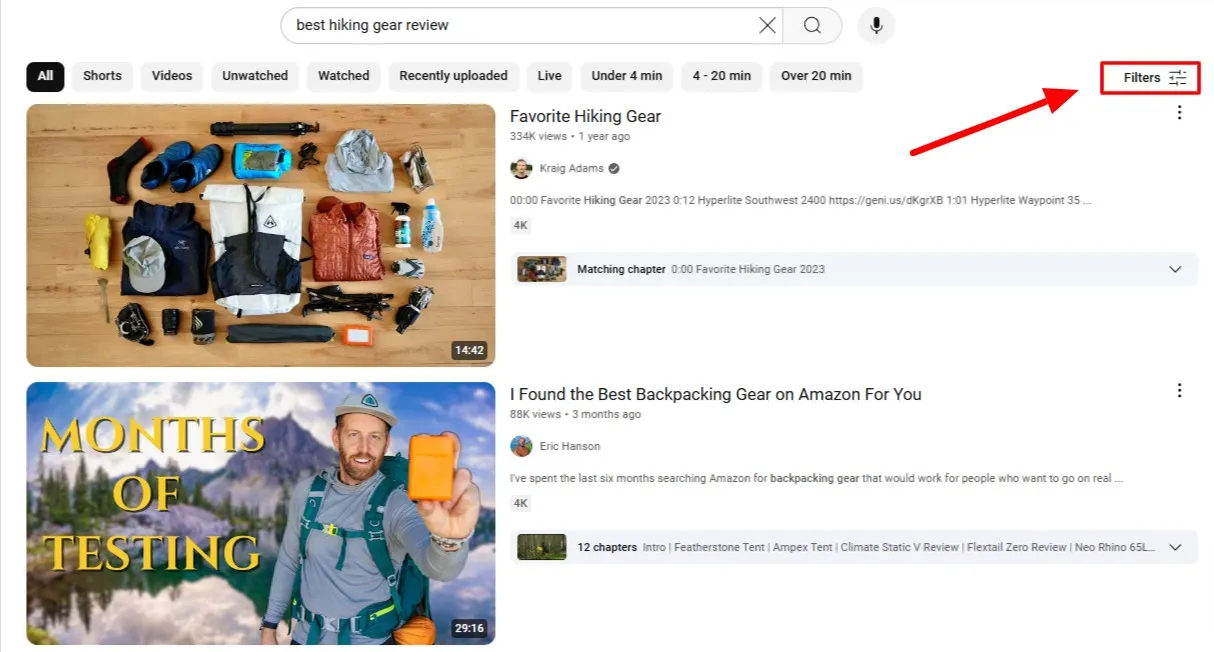
Tip: Expand Beyond Niche. Don’t limit your search to your immediate industry. Consider overlapping markets that connect with your audience. For example, a luxury eco-bag brand could explore influencers in sustainability, travel, or fashion. This approach ensures a broader reach while maintaining relevance to your product.
3. Analyze Sponsored Content and Existing Collaborations
Before collaborating with a YouTube influencer, reviewing their past sponsored content is crucial. This helps you understand their advertising style, brand partnerships, and how well they integrate promotions into their content.
Why Does It Matter?
Not all influencers drive results. Some create authentic, high-impact promotions, while others produce forced or disengaged ads. Checking their past collaborations ensures their audience trusts their recommendations and engages with sponsored content.
How to Do It?
Search for influencers who have worked with brands similar to yours. Look at comment sections and engagement metrics—do viewers seem genuinely interested, or are they skeptical? For instance, Marques Brownlee, known as MKBHD, has partnered with various tech companies, providing in-depth reviews and showcasing products to his extensive audience.
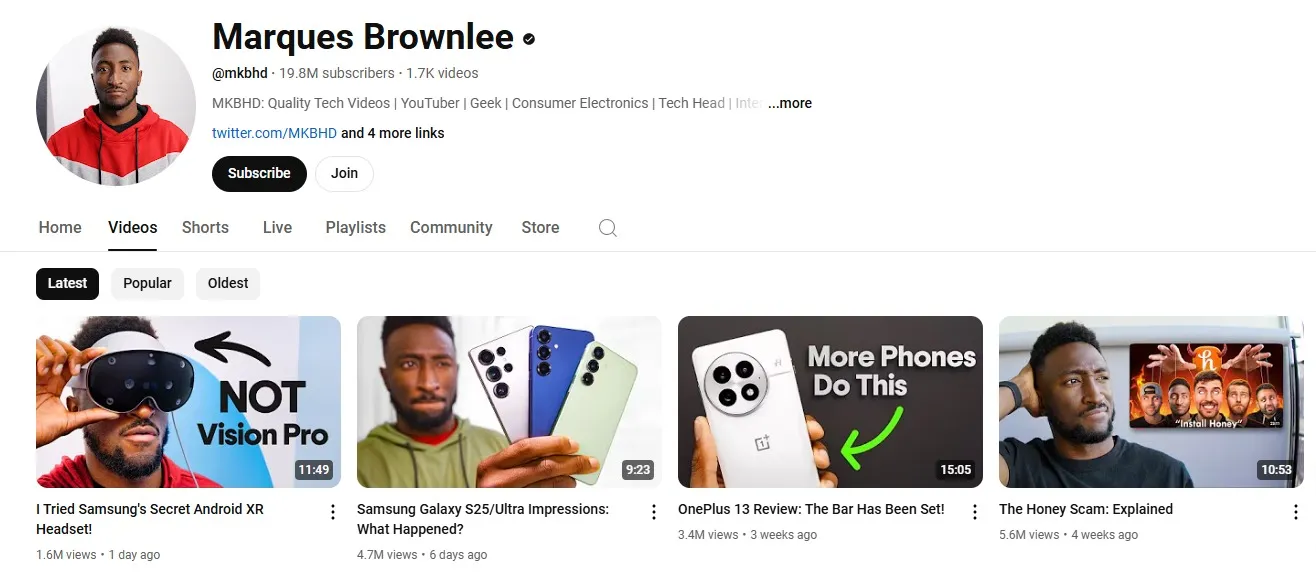
Tip: Look for influencers whose sponsored content feels authentic and resonates with their audience, ensuring a natural fit for your brand.
4. Use Google for YouTube Creators
Google is a goldmine for finding YouTube influencers beyond the platform itself. By pairing niche-specific keywords with terms like “best YouTube influencers” or “top [industry] YouTubers”, you can uncover curated lists, blog articles, and ranking sites that highlight top creators.
Why Does It Matter?
YouTube’s search bar only shows limited results, often favoring mega influencers. Google, on the other hand, provides broader and more niche-focused results, including blog roundups, influencer databases, and media articles that list credible YouTubers in your industry. Plus, local searches help find regional influencers who connect better with location-based audiences.
How to Do It?
Try searching “best fitness YouTubers in New York” if you’re targeting local influencers or “top tech review channels 2024” for gadget endorsements. You can also use Google’s “People Also Ask” and related searches to refine your results.
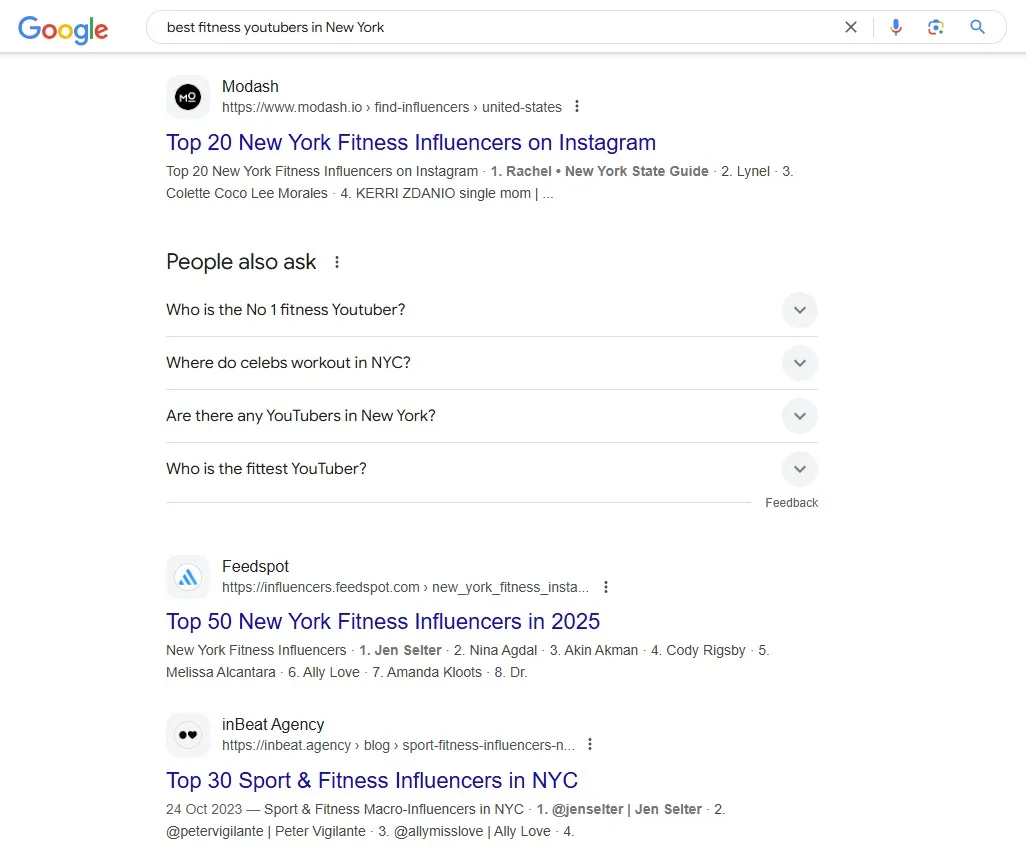
Tip: Save your top finds in a spreadsheet with their engagement stats for quick comparison. You can include details like Youtube channel names, subscriber counts, average engagement rates (likes, comments, and shares), and other contextual information.
Social media platforms like Instagram, TikTok, Twitter, and LinkedIn are hidden goldmines for finding YouTube influencers. Many YouTubers cross-promote their content on these platforms, allowing you to discover them through their posts, collaborations, and audience interactions.
Why Does It Matter?
Not all influencers rank high in YouTube search results, but they often have strong engagement on other platforms. Social media provides a behind-the-scenes look at an influencer’s personality, content style, and audience engagement—helping you determine if they’re the right fit for your brand.
How to Do It?
Search industry-specific hashtags like #TechVlogger #BeautyYouTuber #GamingCreator on Instagram or Twitter to discover YouTubers in your niche. Check their bio sections—many influencers link their YouTube channels there.
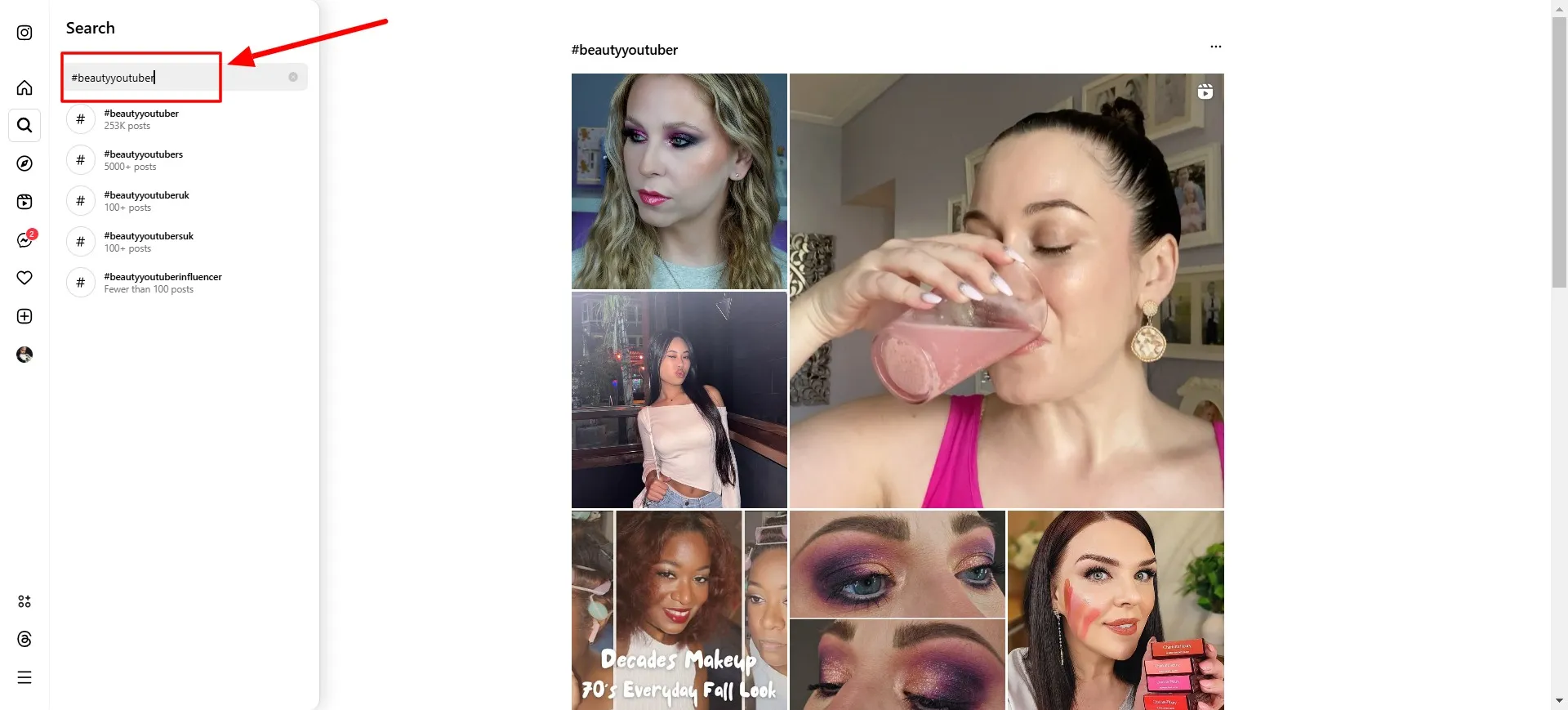
For example, Lauren Giraldo is a well-known YouTuber who actively promotes her content across Instagram, Twitter, and TikTok, making her easier to find for brands looking for lifestyle influencers.
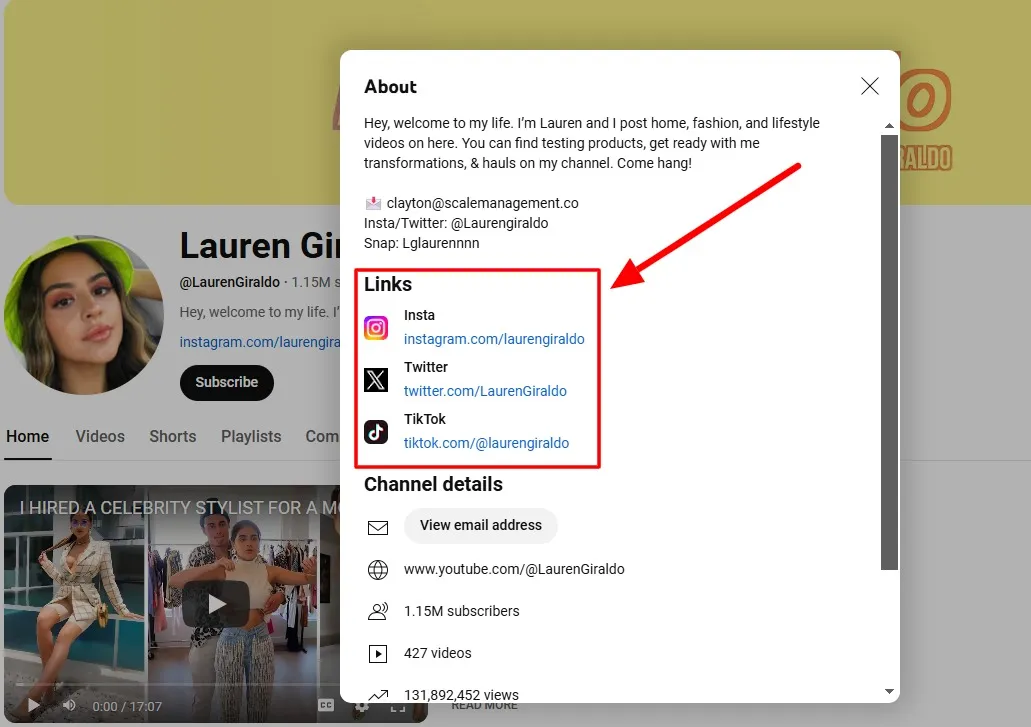
Tip: When you find an influencer, don’t double-check on YouTube immediately—analyzing their engagement on social platforms first gives a more accurate measure of their influence.
Additionally, engaging with YouTube creators on social media helps you build relationships before formal collaboration. Look for creators who actively engage with their followers, share authentic content, and have a tone that resonates with your brand’s values.
Hashtags are a shortcut to discovering YouTube influencers who are actively collaborating with brands. Influencers use hashtags in video titles and descriptions to increase discoverability, making it easier for brands to find creators in specific niches.
Why Does It Matter?
Generic searches on YouTube often highlight popular but broad influencers. Hashtags narrow down results, helping you identify influencers who are open to brand collaborations. Searching for sponsored content hashtags reveals creators who already have experience in influencer marketing, ensuring smoother partnerships.
How to Do It?
Instead of searching generic keywords like “makeup tutorial”, try using niche-specific hashtags such as #crueltyfreebeauty or #veganmakeup. These tags will help you uncover YouTube influencers who align with ethical beauty trends and cater to an audience that values cruelty-free products.
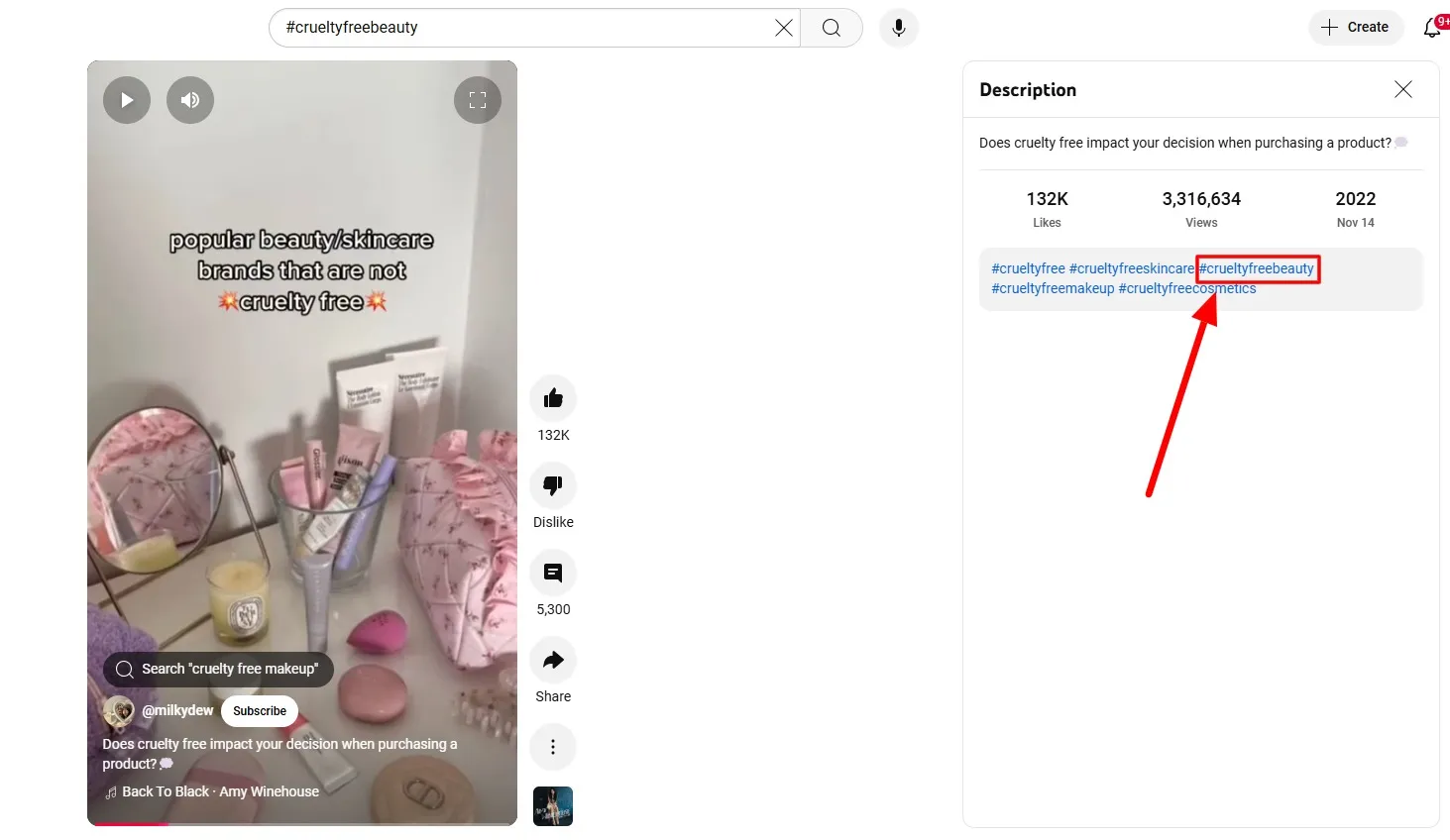
Tip: Go beyond YouTube – search the same hashtags on Instagram and TikTok to discover multi-platform influencers who could amplify your brand across different channels.
7. Target Influencers by Demographics
Finding the right YouTube influencer isn’t just about subscriber count—it’s about ensuring their audience matches your ideal customer.
By analyzing key demographics like age, location, gender, and interests, you can connect with influencers whose followers are more likely to engage with your brand.
You can use tools that provide deep insights into their niche and audience demographics. With the right tools, you can uncover valuable details like audience age, gender, location, and interests that match your brand’s goal.
Why Does It Matter?
A high follower count doesn’t guarantee conversions if the audience isn’t aligned. For example, if you’re a vegan snack brand, partnering with a fitness influencer is great—but their audience should actively engage with plant-based content. Demographic insights help you avoid mismatched collaborations and maximize ROI.
How to Do It?
Start by using an influencer search tool to filter creators based on your target demographics. If your audience is Millennial Women in the United States, search for influencers who have a strong following in that age group and region.

Tip: Check engagement quality, not just numbers! An influencer with 50K subscribers but high comment engagement can drive better results than one with 500K passive viewers.
8. Ask Your Networks or Customers for Recommendations
Sometimes, the best way to find YouTube influencers is by tapping into your existing network. Your colleagues, industry peers, and even customers can provide valuable recommendations based on influencers they follow and trust.
Why Does It Matter?
Word-of-mouth recommendations eliminate guesswork. If an influencer is already resonating with your customers or industry professionals, they’re likely a great fit for your brand. Plus, referred influencers tend to have genuine audience connections, making collaborations more effective.
How to Do It?
Start by asking your team, industry groups, or LinkedIn connections if they know YouTube influencers who align with your niche. Another smart move? Run a quick survey for your existing customers, asking which YouTubers they watch for advice or recommendations.
Tip: Don’t just take recommendations at face value—analyze engagement rates before reaching out. A well-connected but disengaged audience won’t drive the results you need!
9. Collaborate With Agencies for Streamlined Outreach
Influencer marketing agencies bridge the gap between brands and YouTube influencers. They have established networks, industry insights, and the expertise to match brands with the right creators.
Why Does It Matter?
Finding the right YouTube influencer takes time, and not every brand has the resources to vet creators for authenticity and engagement. Agencies eliminate the guesswork by curating influencers based on audience demographics, industry niche, and campaign goals. This ensures a more effective and data-driven influencer strategy.
How to Do It?
Start by researching reputable influencer marketing agencies that specialize in YouTube campaigns. Define your goals—brand awareness, product promotion, or audience engagement.
If you’re a fitness brand, an agency might connect you with YouTube influencers like Pamela Reif, who have an engaged, health-conscious audience.
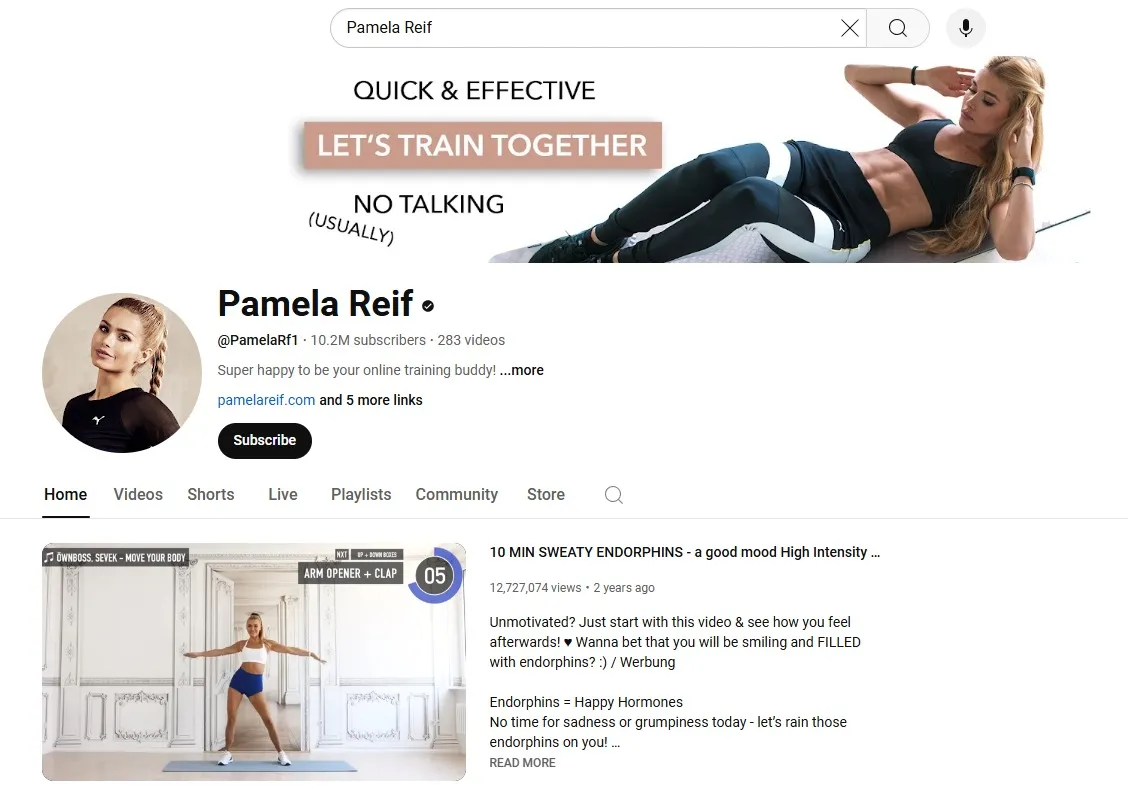
Tip: If you’re new to influencer marketing, agencies can fast-track your success by handling influencer outreach, campaign execution, and performance tracking—saving you time and effort.
Key Factors for Choosing YouTube Influencers
1. Know Your Audience
Pick influencers whose audience matches your brand’s niche. Use subscriber insights to evaluate age, location, and interests. For example, a gaming accessory brand should collaborate with influencers focused on tech and gaming.
2. Prioritize Engagement Over Subscriber Count
A smaller channel with loyal followers often performs better than a larger, disengaged one. Look for influencers with consistent likes, comments, and shares. For instance, an influencer with 10K followers but high engagement can outperform a 100K channel with little interaction.
3. Focus on Authenticity
Authentic influencers create genuine connections with their followers. Check if their past collaborations align with their usual content. An eco-friendly product will resonate better with creators passionate about sustainability.
4. Find Niche Experts
Collaborate with creators who specialize in your industry. For example, a fitness brand can gain better traction with a fitness vlogger than a general lifestyle influencer. Specialized creators build deeper trust in niche audiences.
5. Look for Quality Content
Quality reflects professionalism. Choose influencers whose videos are well-edited, visually appealing, and aligned with your brand. Tools like SocialPilot can analyze content quality and performance metrics.
6. Balance Costs and ROI
Set a realistic budget by evaluating influencers’ engagement and relevance. Nano and micro-influencers charge less and deliver niche engagement, while macro-influencers provide a broad reach for bigger campaigns.
To measure ROI, you can track some of the key metrics like CTR, conversions, and audience growth to ensure your investments steer tangible results.
7. Evaluate Consistency
Consistency builds trust. Work with influencers who upload content regularly and engage their audience consistently. Check their recent posting trends over the past few months to assess their activity level.
8. Analyze Sponsored Content
Scan their sponsored videos for audience feedback. Are followers engaging positively? Authentic promotions spark meaningful interactions. Look for influencers whose collaborations feel seamless and genuine.
9. Assess Audience Sentiment
Audience reactions matter. Check video comments for feedback on sponsored content. Tools like sentiment analysis software help gauge the tone of responses—positive engagement means trust and credibility.
Choosing the right YouTube influencer is crucial to ensuring your brand message resonates with the right audience and effectively achieves your campaigns.
Reaching Out to YouTube Influencers
When reaching out to YouTube influencers, crafting a compelling outreach message is crucial to grab their attention and showcase your brand’s value proposition. Here are some tips to help you create an effective outreach message:
- Personalize Your Message: Address the influencer by their name and mention specific content that resonated with you. Personalization shows that you have taken the time to understand their work and appreciate their efforts.
- Clearly State Your Purpose: Explain why you’re reaching out and what you’re looking for in a collaboration. Be concise and direct to ensure your message is clear.
- Highlight Your Brand’s Value Proposition: Share your brand’s unique selling points and how they align with the influencer’s content and audience. This helps the influencer see the potential benefits of collaborating with your brand.
- Showcase Your Brand’s Credibility: Share relevant credentials, such as awards or recognition, to establish credibility. This can help build trust and make your proposal more appealing.
- Be Clear About Your Expectations: Outline what you want in content, promotion, and engagement. Providing clear expectations helps the influencer understand the scope of the collaboration.
- Include a Clear Call-to-Action: Provide a clear call-to-action, such as scheduling a call or sending a proposal, to move the conversation forward. This encourages the influencer to take the next step.
Example of a compelling outreach message:
Hi [Influencer’s Name],
We’ve been a huge fan of your content on [Specific Topic] and love how you [Specific Aspect of their content]. As a brand specializing in [Your Brand’s Niche], we could collaborate on exciting projects that resonate with your audience.
Our brand is committed to [Your Brand’s Mission] and has been recognized for [Relevant Credentials]. We’re looking for influencers who share our values and can help us reach a wider audience.
I’d love to discuss potential collaboration ideas with you, such as [Specific Ideas]. If you’re interested, please let me know, and we can schedule a call to explore further.
Looking forward to hearing from you!
Best regards, [Your Name]
By following these tips and crafting a personalized, clear, and compelling outreach message, you can increase your chances of successfully collaborating with YouTube influencers who align with your brand’s goals and values.
Conclusion
YouTube influencer marketing is a game-changer for brands aiming to expand their reach, engage audiences, and build lasting relationships. The key to success lies in choosing influencers who align with your brand values, audience demographics, and campaign goals for impactful collaborations.
Start with manual search methods like YouTube search, Google, and social media platforms to explore potential influencers. Then, refine your search using influencer marketing tools to gain deeper insights into audience demographics, engagement rates, and niche relevance. This combination ensures a well-rounded, data-driven influencer marketing strategy.
Ready to elevate your marketing game? Begin your search today!
